Find more information in the General Comments section of the assessment
Find more information in the Rating Validity tab of the assessment
- See More
- See More
- See More
- See More
- Good
- Adequate
- Marginal
- Weak
- Poor
 Passenger
Passenger
 Driver
Driver
 Rear Passenger
Rear Passenger
 Driver
Driver
 Car
Car
 Pole
Pole
 Rear Seat
Rear Seat
 Front Seat
Front Seat
- Good
- Adequate
- Marginal
- Weak
- Poor


Passenger
outboard
center
outboard
Fitted to the vehicle as standard
Not fitted to the test vehicle but available as option
Not Available
-
Infants up to 13 kg
-
Infants and toddlers up to 18 kg
-
Toddlers from 9 to 18 kg
-
Toddlers over 18 kg
Easy
Difficult
Safety critical
Not allowed
| Seat Position | ||||||
|---|---|---|---|---|---|---|
| Front | 2nd row | 3rd row | ||||
| Passenger | Left | center | Right | Left | Right | |
| Maxi Cosi Cabriofix (Belt) | ||||||
| Britax Römer King Plus (Belt) | ||||||
| Britax Römer Duo Plus (ISOFIX) | ||||||
| Britax Römer KidFix (Belt) | ||||||
| Maxi Cosi Cabriofix & EasyFix (Belt) | ||||||
| Maxi Cosi Cabriofix & EasyFix (ISOFIX) | ||||||
| BeSafe iZi Kid X3 ISOfix (ISOFIX) | ||||||
| Maxi Cosi Pearl & Familyfix (ISOFIX) | ||||||
| Britax Römer KidFix (ISOFIX) | ||||||
Easy
Difficult
Safety critical
Not allowed
The Galaxy scored maximum points for its protection of the 1½ year dummy in the dynamic impact tests. Forward movement of the 3 year dummy, sat in a forward-facing restraint, was not excessive in the frontal impact, although neck tensile forces were marginally high. In the side impact, both dummies were properly contained within the protective shells of their restraints, minimising the likelihood of head contact with parts of the vehicle interior. The front passenger airbag can be disabled to allow a rearward-facing restraint to be used in that seating position. Clear information is provided to the driver regarding the status of the airbag and the system was rewarded. All of the restraint types for which the Galaxy is designed could be properly installed and accommodated in the vehicle, including those in the optional third row seats.
- Good
- Adequate
- Marginal
- Weak
- Poor

Head Impact 16.8 Pts
Pelvis Impact 5.8 Pts
Leg Impact 6.0 Pts
The bumper scored maximum points, showing good protection to pedestrians' legs in all areas tested. The pelvic area was well or adequately protected. The bonnet offered predominantly good or adequate protection to the head of a struck pedestrian, with poor results recorded only on the stiff windscreen pillars. The Galaxy's optional-fit autonomous emergency braking system recognises pedestrians as well as other cars. Euro NCAP will start to assess the performance of such functionality in 2016 so the system cannot be rewarded here.
- Good
- Adequate
- Marginal
- Weak
- Poor
| System Name | Speed Limiter |
| Speed Limit Information Function | Camera based |
| Warning Function | System advised |
| Speed Limitation Function | Manually or automatically set |
| System Name | ESP | |
| Performance | ||
| Vehicle Yaw Rate @ COS + 1.00 s | 3.1% | meets ECE requirements |
| Vehicle Yaw Rate @ COS + 1.75 s | 1.7% | meets ECE requirements |
| Lateral Displacement @ BOS + 1.07 s | 3.4 m | meets ECE requirements |
| Applies To | All seats | ||
| Warning | Driver Seat | Front Passenger(s) | Rear Passenger(s) |
| Visual | |||
| Audible | |||
|
|||
| System Name | Lane Keeping Alert and Lane Keeping Aid |
| Type | Lane Departure Warning and Lane Keep Assist |
| Warning | Visual & Haptic |
| Performance | |
|
LDW Confirmation Test
|
Pass |
Electronic stability control is standard equipment, as is a seatbelt reminder system for the front and rear seats. A lane assistance system is an option that is expected to be widely fitted. The system combines lane departure warning with lane keeping assistance i.e. it will warn the driver if the car is drifting to the edge of the lane and will automatically steer the car gently back into its lane if needed. A speed assistance system is also an option. It uses a camera to detect the local speed limit and provides this information to the driver, who can then set the speed limiter appropriately or allow the system to do so automatically. An autonomous emergency braking system is available as an option but is not expected to be sold in sufficient numbers to qualify for assessment here.
- Specifications
- Safety Equipment
- Videos
- Rating Validity
Specifications
Tested Model Ford Galaxy 2.0 diesel 'Titanium', LHD
Body Type - 5 door wagon
Year Of Publication 2015
Kerb Weight 1779kg
VIN From Which Rating Applies - applies to all Galaxy's of the specification tested
Class Large MPV
Safety Equipment
Note: Other equipment may be available on the vehicle but was not considered in the test year.
Fitted to the vehicle as standard
Fitted to the vehicle as option
Not fitted to the test vehicle but available as option
Not Available
Not Applicable
Videos
Rating Validity


Find more information in the General Comments section of the assessment
 Share
Share
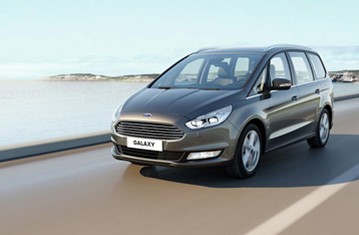
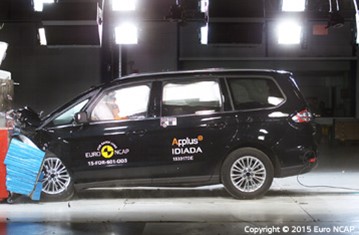
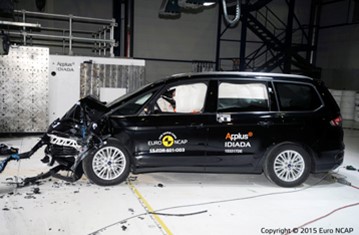

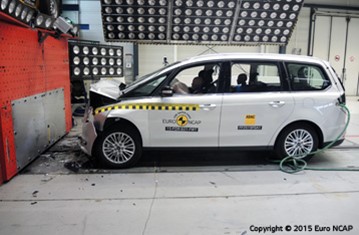
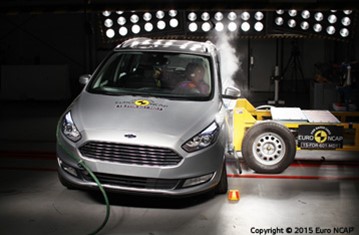
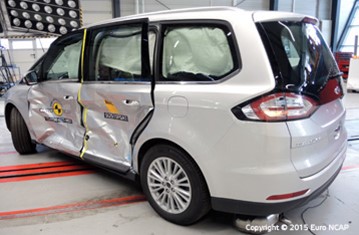
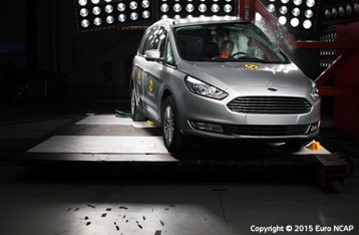
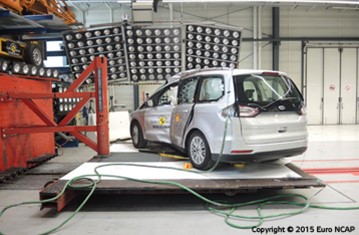



The passenger compartment of the Galaxy remained stable in the frontal impact. All critical body areas of the passenger dummy were well protected. Dummy readings showed good protection for the knees and femurs of both the driver and passenger dummies. Ford showed that a similar level of protection would be provided to occupants of different sizes and to those sat in different positions. In the full width rigid barrier test, protection of all body areas was good for except for the chest. Dummy readings indicated adequate chest protection for the driver dummy and marginal chest protection for the rear passenger. The Galaxy scored maximum points in both the side barrier impact and the more severe side pole test, with good protection of all body areas. The front seats and head restraints provided good protection against whiplash injuries in the event of a rear-end collision. A geometric assessment of the rear seats, including the optional third row, indicated poor whiplash protection for those seating positions. An autonomous emergency braking system is available as an option but does not qualify for assessment as it is not standard equipment.